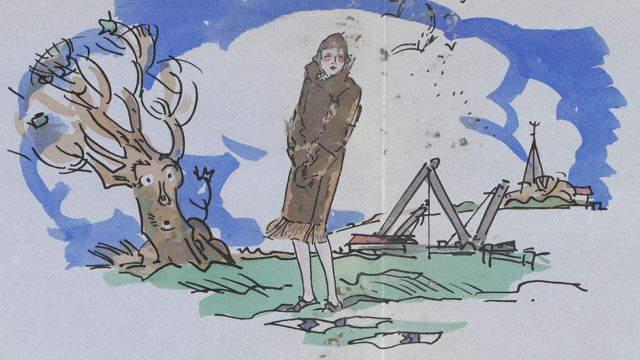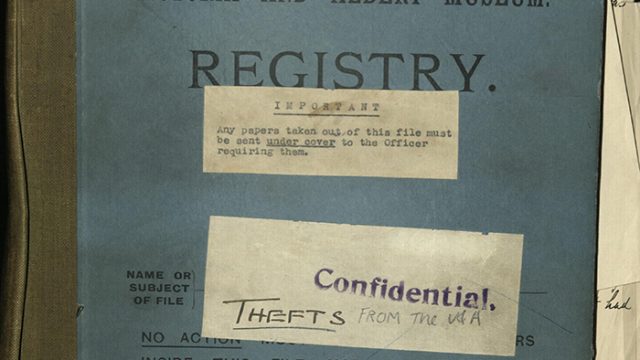The Cast Courts are still the most impressive spaces in the V&A and the plaster cast of Trajan’s Column is at once the most dominant and perhaps most surprising cast in the voluminous Western Cast Court, competing only with the Portico de la Gloria from Santiago de Compostella for attention. Aided by the vibrant original colour scheme, last recreated in the 1980s, these casts offer a thrillingly vertiginous experience not to be found anywhere else in the Museum. The scale of the Western Cast Court, and Trajan’s Column planted in the centre of it, comes vibrantly alive in an anonymous late 19th century watercolour that may have been completed to show the original wall colour scheme of ‘olive-green and purple-red’.

This week sees the V&A and the Romanian Cultural Institute launch a programme of events to celebrate the 1900th anniversary of Trajan’s Column and 140 years of the V&A’s Cast Courts. You can find out more about the celebrations here.
More information about the original Column and the V&A’s cast can be found here. The V&A Archive holds a range of documents and photographs which chart the history of not only the Cast Courts but also of Trajan’s Column and its changing fate over the years.
The plaster cast of Trajan’s Column was acquired in 1864 and a few sections were displayed in the newly opened North Court, now used as the temporary exhibition space. Photographs from this time show it displayed with an assortment of casts and a fernery in the distance.

The purpose-built Cast Courts were completed in 1873 and were built to a height of 25 metres specifically to enable the Column to be accommodated, admittedly displayed in two parts. Here it has remained ever since and has stoically resisted being moved and even disposed of. The V&A Archive holds the original specification documents for the Cast Courts that detail the construction required for the building’s carcase. Before they were opened the Museum tried to keep secret the contents of these new Courts and on the specification they are accordingly simply called the ‘South East Court’.

Although the Cast Courts opened in July 1873 the building of Trajan’s Column was not completed until 1874. The V&A Archive holds photographs showing the individual casts of the column being assembled around a brick core and also the estimate of £233 from George Smith and Co. for building this core.


The commissioning of casts of the base plinth was seemingly an after-thought. The electrotypes of the four faces of the base held in the Musée du Louvre, Paris, had become buckled and had to be straightened out before the plaster cast was made. Records in the Archive reveal that “M. Maitre is to undertake casting of pedestal for 5,000 francs. Department will defray carriage (200 francs) of electrotypes requisite from Paris to St. Germain.” (1). A rejected tender from a G. Berger for this casting work includes a jolly sketch of the base.

By 1874 the cast and plinth were complete and were for the most part appreciated by the public and art critics. In Chapter 10 of his 1900 novel Love and Mr Lewisham the author H.G. Wells described the impact of seeing the Cast Courts and Trajan’s column from the Cast Courts Gallery: ‘… over the balustrade one may lean and talk of one’s finer feelings and regard Michael Angelo’s horned Moses, or Trajan’s Column (in plaster) rising gigantic out of the hall below and far above the level of the gallery’. (2)
A late-19th century depiction of the Cast Courts by H.E. Tidmarsh gives a sense of scale of the Column and shows visitors enjoying the space.

In the early 20th century as emphasis was placed on original works of art, interest in casts and other reproductions waned and the Cast Collection was seen to be irrelevant both in art education and to the art lover. Indeed the 1908 report of the Museum’s Committee of Re-arrangement resisted the notion of mixing casts with original art works, suggesting snootily that ‘… the attempt to make the Museum combine with its proper functions those of a Trocadero would be in every way disastrous.’ (3) At this point the Cast Collection remained untouched.
However, by 1928 the Museum’s opinion was moving further against the Cast Collection. A report by the architect Sir Reginald Blomfield to the V&A’s Advisory Council proposed the Museum should dispose of the Cast Collection in its entirety to the Crystal Palace. He described the collection as ‘unworthy of the Museum and … actually injurious to students’, commenting that Trajan’s Column ‘… in two sections giving an utterly wrong idea of the effect of the column as it is’. (4)
The Column was not removed but in 1934 the V&A’s Director Sir Eric Maclagan wrote to the British Museum’s Director Sir George Hill of his ‘personal desire to get rid of it’ (5), describing it as ‘a most incongruous white elephant’. (6) Maclagan felt that ‘… almost any place that could found for it would be more appropriate than the centre of our collection of Gothic and Romanesque casts’ and he was hoping to foist the Column on to University College London, with Hill even suggesting ‘… coating it with some waterproof stuff and sticking it up, in sections, in the porch!’ (7)

After the Second World War the fate of the Cast Collection was looking more promising, with Sir Kenneth Clark reporting to the V&A’s Advisory Council in 1955 of the importance of the Collection, despite it being disparagingly described almost in the same breath as ‘quasi-instructional lumber’. (8)
The V&A Cast Collection and Trajan’s Column have survived to this day ensuring the Cast Courts remain one of the most evocative Victorian spaces in the Museum. Even today it’s possible to be bowled over by the Column, the V&A’s ‘white elephant’, standing proud as it does in the centre of the room.
1. V&A Archive, ED84/36 Precis of the Board minutes of the Science and Art Department. Vol. II and III, entry for 13 July 1872.
2. H.G. Wells, Love and Mr Lewisham. London: Harper Brothers, 1900.
3. V&A Archive, A0158 Report of the Committee of Rearrangement, 1908.
4. V&A Archive, MA/46/1/2 Minutes No. 36 of the Advisory Council: Memorandum ‘Architectural exhibits and a note on the Cast Courts in the Museum’ by Sir Reginald Blomfield, 26th January 1928.
5. V&A Archive, MA/2/T6, Nominal File: Trajan’s Column: Letter from Sir Eric Maclagan to Sir George Hill, 6th February 1934.
6. V&A Archive, MA/2/T6, Nominal File: Trajan’s Column: Letter from Sir Eric Maclagan to Professor Bernard Ashmole, 16th February 1934.
7. V&A Archive, MA/2/T6, Nominal File: Trajan’s Column: Letter from Sir George Hill to Sir Eric Maclagan, 15th February 1934.
8. V&A Archive, MA/46/1/5 Minutes No. 97 of the Advisory Council, 8th October 1953.


